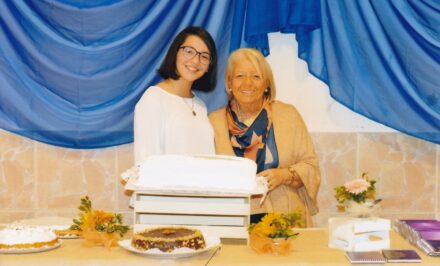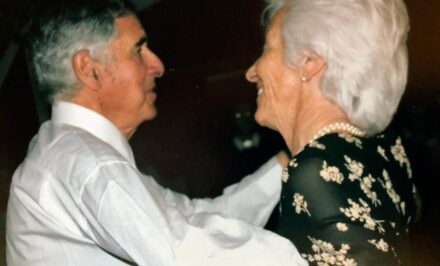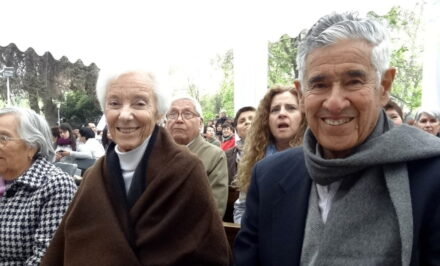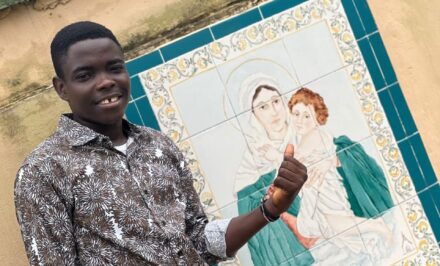
GERMANY, fma. On account of his long name he was simply called “OB” or “Obi”: Fr Ludwig Obereisenbuchner, an old hand in Schoenstatt in the Diocese of Augsburg and the Schoenstatt Centre in Memholz, was called to his eternal home with the Father. His funeral took place on 28 March at 2 p.m. in Martinzell, his last parish. Fr Obereisenbuchner was a member of the Schoenstatt Diocesan Family Council in the 1960s. It was a time when the Schoenstatt Family surrendered itself completely to the Blessed Mother in the covenant of love as a pledge for the future Schoenstatt Centre in Memholz and the return of Fr Kentenich from exile. In addition, Fr Obereisenbuchner was for many years the chairman of the Josefswerk e.V., the supporting association of the Schoenstatt Centre in Memholz.
![]()
Endowed with a distinctively artistic talent, connected with great openness for anything technical and the possibilities it could open up for pastoral work and work in the Movement, Fr Obereisenbuchner’s work in a number of parishes and the Schoenstatt Movement was richly blessed. He was the leader of the Schoenstatt youth and later of the mothers’ League, and something like a living history of building operations until the end. For the Open Day in 2013, held to commemorate the forty years since the dedication of the house, he compiled a beautiful presentation that was very well received. The foundation stone of the house, the pillar in the house chapel with the tabernacle and MTA picture, and much more, were designed and influenced by him.
Fascinated by practical faith in Divine Providence
 All who got to know him a bit better knew what fascinated him in a very special way in Schoenstatt. It was our practical faith in Divine Providence. It was his world. It is also what gave him a certain light-heartedness even in his last days, and preserved his sense of humour.
All who got to know him a bit better knew what fascinated him in a very special way in Schoenstatt. It was our practical faith in Divine Providence. It was his world. It is also what gave him a certain light-heartedness even in his last days, and preserved his sense of humour.
A life captured in memories
A life such as that of Fr Obereisenbuchner does not fit into the format of a traditional obituary, or a brief biography. Such a life is better captured in memories and impressions:
For the last two years Fr Obereisenbuchner suffered from pulmonary fibrosis. As a result he was only able to move with the help of an electric wheelchair, but he was always cheerful and full of humour when I phoned him a few times in the last weeks, or contacted him by email. Last week he suffered from acute pneumonia. Today he was called to his eternal home. “Do we look forward joyfully to heaven?” was the subject of his sermon during our last pilgrimage to the shrine. In the last two or three years I often heard him saying how consciously and purposefully, and with what inner joy, he was approaching this hour. The pilgrimages to the shrine, which Sr Martina conducted with him over many years, were his idea, and besides providing the spiritual accompaniment to these journeys, it was a “matter of honour” to him to send out the invitations and compile the programme booklets and photo documentation.
Sr Ingrid-Maria Krickl, Pilgrimage Leader in Memholz
For many years, even decades, Fr Obereisenbuchner was the leader for the Schoenstatt youth – young men and women. It fell in the difficult time of our Founder’s exile and the new orientation. Fr Bader left a legacy that directed everything to Schoenstatt. “OB” was the guarantor for the young men of loyalty to Schoenstatt in those difficult years. At the time he was parish priest in Penzberg, and supported the young men in every possible way. He was always up-to-date in the technical field; at the time it was printing technology. In the committees (DFR and e.V.) he was always present and co-operated actively. He contributed his artistic abilities, for example, in designing a Father Symbol for the parish church in Nordendorf. The priests of his generation left their mark in word and picture on the Schoenstatt Movement and beyond.
Mr Drexler knew and valued him from his time in the Young Men’s groups
I lived in Martinzell from 1988-1992 and Obi (as we called him) was my parish priest. I have lively memories of the following: He was very interested and well versed in technical things. There was a printing press in the presbytery that almost filled a room. Here he personally printed the things needed for the parish, but also the advertisements for the Martinzell Youth Theatre. He set great store by a solemn celebration of the liturgy and the work of altar servers. On feast-days there were more than forty altar servers (at that time only boys could serve) at the altar. I sill like to remember those beautiful Masses with the choir, and the really solemn washing of the feet on Maundy Thursday, etc. Fr Hatosch (Priests’ Federation) was once one his altar servers. He said that in the past he had been very impulsive. Apparently he was often teased as a child and reacted angrily. He found it important to emphasise that through Schoenstatt and the Blessed Mother he had been given a more balanced character. Almost to the end he took a lively interest in everything that happened in Schoenstatt. He always answered personally to the information about the school we sent him. This was his answer to an invitation to the dedication of our extension, “Dear Ms Immler, many thanks for the invitation to 26 October 2013. Unfortunately my health does not allow me to be present, but I will be there in spirit and with my prayers, and I am extremely grateful for your commitment. May great blessings go out from this school. With my priestly greeting and blessing, Yours, Ludwig M. Obereisenbuchner, parish priest (retired).”
Ms Renate Immler, Kempten, knew him as a person who was always open tor new projects, and accompanied them with interest.
His strength was to take up life and pass it on
 Fr Leonhard Erhard describes his confrere’s life in Schoenstatt and his work in Schoenstatt:
Fr Leonhard Erhard describes his confrere’s life in Schoenstatt and his work in Schoenstatt:
Although I was close to him in the last two years of his suffering and illness, I was nevertheless shocked by his death within so few days. His personal life in Schoenstatt and then his activity have been an example to me and show many comparisons to the Founder.
Ludwig O. lost his parents when he was still young, and although he was taken in by his grandparents, he developed a longing for a mother that made him very open for the MTA picture and the Blessed Mother’s role in Schoenstatt. As a young seminarian he encountered Schoenstatt while doing a placement in Ingolstadt with Fr Otto Maurer, and Fr Heinz Dresbach gave a talk on faith in Divine Providence. To see God and all that happened in such a personal way, and to experience it so simply in everyday life in the way Fr Kentenich had done, became the cornerstone of his faith. He also knew how to open doors with it for young confreres and enable them to become men of God rather than pastoral tradesmen.
During Fr Kentenich’s exile it required the special work of the Blessed Mother and God’s Spirit to get anyone to join Schoenstatt and feel called to do so. His way of getting to the root of controversial questions by following our founder’s way of thinking, and his ability to come to decisions, made him a strong supporter of life when he placed his priestly service at the disposal of the different sections of the Movement. In his first years as parish priest in Penzberg he supported the young women, then the young men, and finally for about twenty-four years the Mother’s League.
He was one of the old hands of the diocesan centre, and along with the Family Council made the Inscriptio Consecration on 20 January 1962 in Dachau for the return of the Founder from exile and permission to build a diocesan shrine. In his very simple way he lived what he had expressed, and along with his course placed the discipleship Act into the hands of the liberated Founder. This gave him strength for the rest of his life. Today the main core of the Schoenstatt Family in the diocese of Augsburg is made up of the many young people for whom he had formerly been a leader.
With his artistic gifts and creativity he from the beginning made use of all the technical possibilities of the media for his pastoral work. This greatly impressed the youth, and gave great joy to the many people and parishes when they read his church notices and pilgrimage booklets.
His strength was to take up life and pass it on, and this brought great joy to the diocesan family. His life has left its mark not only on the house chapel in Memholz, but also on all the events and feasts, and people will always feel invited to follow up the traces he has left on his way home to the Father.
Original: German. Translation: Mary Cole, Manchester, England













